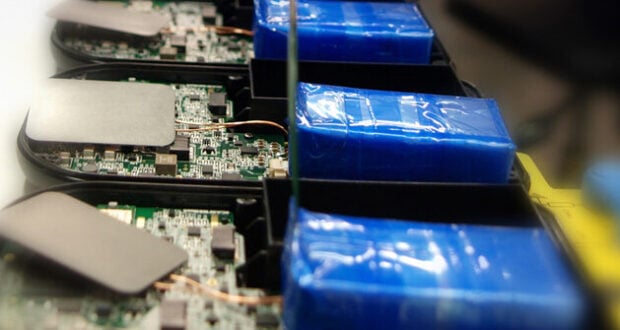Kromek Group (LON:KMK) Chief Executive Officer Arnab Basu caught up with DirectorsTalk for an exclusive interview to discuss their two new contract extensions and further growth.
Q1: Two extension contracts from European and US customers, what can you tell us about them?
A1: These are two contracts from two very important customers in the field of radiation detection, particularly nuclear security markets and both these contracts are a demonstration of our continued traction in this market.
One is from the US, from CWMD which is an agency department of Homeland Security in the US, and this is very much to supply products from our D3S family of products which are used for detecting radiation which could be harmful and be used by nuclear terrorists. We have a long history of working with the Department of Homeland Security and the Department of Defense in America and this is just a manifestation of our very strong relationship with these very important agencies in the US.
The second contract is really from a European government agency and this is a good demonstration of the global traction we are getting for this product range so it was, of course, developed for the US government with the US government but we are seeing demand coming through from around the globe. This £1 million is a very good example where this product is going into other areas of the world, looked at seriously by other governments for large scale deployment.
Q2: Can you just remind us what the D3S family of products actually do?
A2: D3S is the small pager size handheld radiation detector which detects gamma rays and neutrons which gamma rays and neutrons are emitted from radioactive material, or nuclear material. The purpose of this particular product is to detect, identify and confirm whether there is radiation, what type of radiation is coming out, if there is radiation, from what material and how much radiation is coming out.
So, this product was developed under the US Department of Defense contract from an agency called DARPA, very much in at developing small compact handheld detectors to be carried around by first responders or other personnel in large numbers dispersed in urban areas. It then sends a realtime signature of radiation of that particular area together with the GPS coordinates so it can build a realtime heat map of radiation of a very large dispersed area, it’s very much aimed as a realtime monitoring system for detecting movement of radiation primarily for against nuclear terrorism, an early warning system against a nuclear dirty bomb.
This is a unique product, in the US government’s own words, this is a product which is replacing traditional products which are the size of a shoebox and cost tens of thousands of dollars with something which is a pager-sized device, very much a wearable radiation detector, cost only a few thousands dollars.
So, it is a disruptive product that was developed for the US government, with US government funding and deployed in the US, in major urban areas, and now getting traction around the world.
Q3: Nuclear detection isn’t the only thing that you do, you also do medical and security screening operations. How are they progressing?
A3: Very much so. We, as a business, we serve three markets which are medical imaging, nuclear detection and aviation security or security screening. All three markets are global, all three markets are growing and we have a very well defined product portfolio, target customer and target applications. Medical imaging and nuclear detection are the two of our larger markets.
So, in medical imaging, of course we don’t serve the entire medical imaging we serve four sub-segments within the diagnostic imaging markets:
- Bone mineral densitometry which is used for detection of osteoporosis.
- Gamma probes where probes are used during removal of lymph nodes, interoperative probes used by surgeons.
- SPECT, which is nuclear medicine, which is used for detection of cancer, cardiac diseases and many other kind of conditions and increasingly going into dementia-related application.
- CT, computer tomography, which is one of the largest diagnostic modalities using x-ray’s.
In all of those four sub-segments within the medical market, we are an OEM detector supplier, we don’t make end-user products. We supply detector assemblies which contains our unique CZT material, electronic signal pulses and capability into assemblies which then fits into OEM’s imaging system.
Bone mineral densitometry and gamma probes are two market where we have served that market over the last 8-10 years pretty successfully, there are thousands of devices and systems around the world which as used in clinical environments and hospitals around the world, scanning patients every day.
SPECT is a really growing market for us, going through real growth which is evidenced by some of the news flow you’ve seen in the last 12-18 months including one of our largest contracts we announced earlier this year.
So, we’re making good progress in the medical imaging market, we have a unique position with our technology, IP and the increasing customer base so we remain very confident of growth within that market.
Security screening, we have got two parts, one is we sell an end-0user product which is used now in over 60 airports around the world for screening liquids in bottles and containers, this is a regulatory certified device which is used everyday in real airports now.
The second part of that business is where we supply OEM modules and advanced algorithms to baggage screening manufacturers and that’s the part of the market that’s growing for us, driven by the new regulatory changes that have been implemented both in Europe and around the world. Our customers are using our products to achieve higher standards of performance for their own baggage screening systems and that is what is driving growth. Again, if you look back 6/9/12 months, you will see a number of OEM contracts that we have announced, typically multi-year contracts with OEM’s and things are going well and regulation is driving growth.
Q4: Talking about growth, where do you see growth coming from in the next 6-12 months for Kromek Group?
A4: If you look at our business at the moment, we are looking at making pretty good progress in all three segments but we have to standout big opportunities in front of us.
One is the D3S product range which we believe, collectively, the total market for us, over the next 10 years, is over $1 billion and we have a unique offering in there.
The second is medical SPECT, the nuclear medicine modality, where we have a very strong well differentiated offering for the SPECT market as the market is transitioning from black and white to colour high resolution SPECT.
So, over the next 6/12/24/36 months, we’re going to see steady progress in all of our markets but two with two real growth drivers which can give us substantial and visible growth.







































